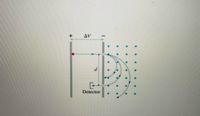Question
A hydrogen isotope separator contains positively ionized hydrogen H^1, with isotope of hydrogen, Deuterium D^2, and other heavy particles, and the ions were released in a potential difference of 200 Volts. The strong magnetic field of 1.4x10^-2 Tesla (out of the page), bends the ions and Deuterium is collected on separate ionic trap as shown in the figure. (Masses MH1=1.67x10^-27 kg, MD2 = 2* MH1, Q(H1, D2) = 1.6x10^-19 C.
What is the potential energy of plates having the voltage difference of 200 Volts acting on Deuterium in unit of 10^-17 Joules?

Transcribed Image Text:The diagram illustrates the motion of charged particles in a uniform electric field. It consists of two parallel plates with a potential difference, labeled \(\Delta V\), creating an electric field between them.
- **Plates Configuration**:
- The left plate is marked with a positive \(+\) sign, and the right plate with a negative \(–\) sign.
- The distance between the plates is labeled \(d\).
- **Charge Movement**:
- A red dot near the positive plate represents a charged particle, which is shown to move towards the negative plate.
- Curved lines with arrows depict the path of the particle, bending due to influences on its trajectory.
- **Field Lines**:
- Blue dots arranged in a grid pattern represent the field lines, showing the direction of the electric field from the positive to the negative plate.
- **Detector**:
- A detector is positioned beyond the negative plate to capture the moving particle. The detector's location is indicated below the path.
This setup is commonly used to study particles' behavior in electric fields and is fundamental in physics experiments and applications.
Expert Solution
This question has been solved!
Explore an expertly crafted, step-by-step solution for a thorough understanding of key concepts.
This is a popular solution
Trending nowThis is a popular solution!
Step by stepSolved in 3 steps with 1 images

Knowledge Booster
Similar questions
- Why does this part not require a Sin(30) to decompose the MG(Sin(30))(.8)? The example gives a correct answer.arrow_forwardUsing the given charge-to-mass ratios for electrons andprotons, and knowing the magnitudes of their charges areequal, what is the ratio of the proton’s mass to the electron’s?(Note that since the charge-to-mass ratios are given to onlythree-digit accuracy, your answer may differ from theaccepted ratio in the fourth digit.)arrow_forwardA hydrogen isotope separator contains positively ionized hydrogen H^1, with isotope of hydrogen, Deuterium D^2, and other heavy particles, and the ions were released in a potential difference of 200 Volts. The strong magnetic field of 1.4x10^-2 Tesla (out of the page), bends the ions and Deuterium is collected on separate ionic trap as shown in the figure. (Masses MH1=1.67x10^-27 kg, MD2 = 2* MH1, Q(H1, D2) = 1.6x10^-19 C) What are the velocities of the Deuterium when exiting the plates, in unit of 10^5 m/s?arrow_forward
- A USATestprep, LLC - Online State t x odules/questions/qq.php?testid=1745&assignment_id3D47667397&strand=8721&element=73561&totalQuestions=.. Wages - Prote. ne to Beta PRACTICE I HELP JULIE Y GIA RESS GNMENTS ASSIGNMENT 1 23 4S 89 10 Save Submit Two identical charges are separated by a distance d. If the distance between them is increased to 3d, what will happen to the force of repulsion between them? es ) A) It wilt be one-ninth the original force. B) It will be one-third the original force. C) It will be nine times the original force. D) It will be three times the original force. Electrical and Magnetic Forces Regular Calcarrow_forwardThe magnetic dipole moment of a deuterium nucleus is about 0.0005 Bohr magneton. What does this imply about the pres- ence of an electron in the nucleus, as the proton-electron model requires?arrow_forwardRose bengal is a chromophore used in biological staining that has an absorption maximum at 559.1 nm and several other shorter wavelength absorption bands in the ultraviolet and visible regions of the spectrum when dissolved in ethanol. What is the energy difference, in kilojoules per mole, between the absorption maximum at 559.1 nm and a band at 221.5 nm? E = kJ/molarrow_forward
arrow_back_ios
arrow_forward_ios